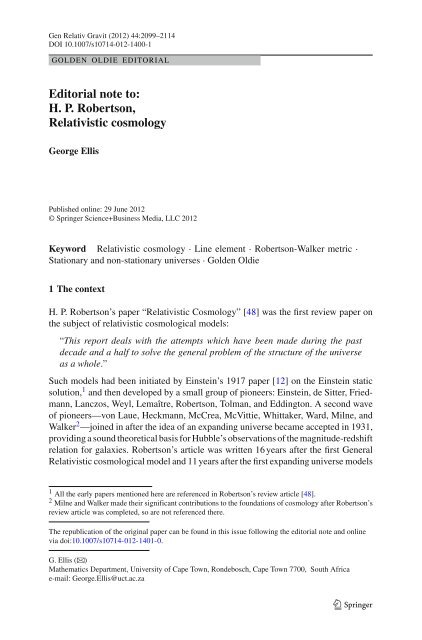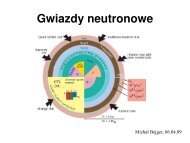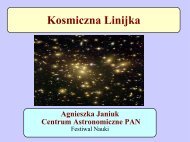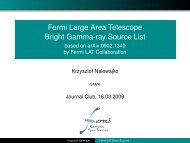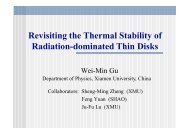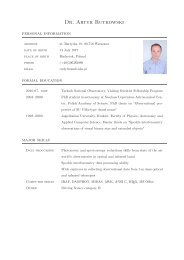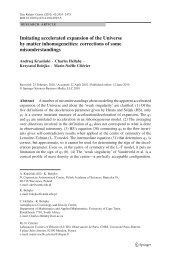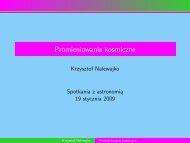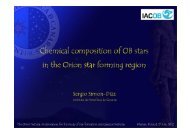Editorial note to: HP Robertson, Relativistic cosmology - Users' Pages
Editorial note to: HP Robertson, Relativistic cosmology - Users' Pages
Editorial note to: HP Robertson, Relativistic cosmology - Users' Pages
Create successful ePaper yourself
Turn your PDF publications into a flip-book with our unique Google optimized e-Paper software.
Gen Relativ Gravit (2012) 44:2099–2114DOI 10.1007/s10714-012-1400-1GOLDEN OLDIE EDITORIAL<strong>Edi<strong>to</strong>rial</strong> <strong>note</strong> <strong>to</strong>:H. P. <strong>Robertson</strong>,<strong>Relativistic</strong> <strong>cosmology</strong>George EllisPublished online: 29 June 2012© Springer Science+Business Media, LLC 2012Keyword <strong>Relativistic</strong> <strong>cosmology</strong> · Line element · <strong>Robertson</strong>-Walker metric ·Stationary and non-stationary universes · Golden Oldie1 The contextH. P. <strong>Robertson</strong>’s paper “<strong>Relativistic</strong> Cosmology” [48] was the first review paper onthe subject of relativistic cosmological models:“This report deals with the attempts which have been made during the pastdecade and a half <strong>to</strong> solve the general problem of the structure of the universeas a whole.”Such models had been initiated by Einstein’s 1917 paper [12] on the Einstein staticsolution, 1 and then developed by a small group of pioneers: Einstein, de Sitter, Friedmann,Lanczos, Weyl, Lemaître, <strong>Robertson</strong>, Tolman, and Edding<strong>to</strong>n. A second waveof pioneers—von Laue, Heckmann, McCrea, McVittie, Whittaker, Ward, Milne, andWalker 2 —joined in after the idea of an expanding universe became accepted in 1931,providing a sound theoretical basis for Hubble’s observations of the magnitude-redshiftrelation for galaxies. <strong>Robertson</strong>’s article was written 16 years after the first General<strong>Relativistic</strong> cosmological model and 11 years after the first expanding universe models1 All the early papers mentioned here are referenced in <strong>Robertson</strong>’s review article [48].2 Milne and Walker made their significant contributions <strong>to</strong> the foundations of <strong>cosmology</strong> after <strong>Robertson</strong>’sreview article was completed, so are not referenced there.The republication of the original paper can be found in this issue following the edi<strong>to</strong>rial <strong>note</strong> and onlinevia doi:10.1007/s10714-012-1401-0.G. Ellis (B)Mathematics Department, University of Cape Town, Rondebosch, Cape Town 7700, South Africae-mail: George.Ellis@uct.ac.za123
<strong>Edi<strong>to</strong>rial</strong> <strong>note</strong> <strong>to</strong>: H. P. <strong>Robertson</strong>, <strong>Relativistic</strong> <strong>cosmology</strong> 2101leaving. He defines a <strong>to</strong>tal mass M and energy E (3.5) for such a volume, the lattergenerally not being constant because it is composed of both matter and radiation [see(9.1)]; rather it satisfies the thermodynamic law (3.6), which follows from the conservationequation (3.3). Neither M nor E is constant if matter is transformed in<strong>to</strong>radiation [see (9.9)].At this point no equations of state have been given for the matter, so <strong>Robertson</strong> suggestsrunning the field equations backwards <strong>to</strong> determine the density ρ and pressurep from arbitrary k, λ, and R(t) but subject <strong>to</strong> the inequality p ≥ 0. He then quicklyretreats from this proposal, 4 which is currently highly disfavored because it producesnon-physical solutions of the field equations, and proposes integration of the Friedmannequation [the first of (3.2)] <strong>to</strong> give t(R) by the quadrature (3.7,3.8), with Egiven by (3.5). Before turning <strong>to</strong> solutions, he shows how <strong>to</strong> integrate timelike andnull geodesics, the latter giving a velocity-distance relation (4.6) leading <strong>to</strong> a linearredshift-distance relation (4.9) given in terms of spatial distance l and the wavelengthchange λ/λ. 5 He then identifies the existence of observational limits, characterizedby the radius l(t) of the observable universe at time t. 6 He comments on being able <strong>to</strong>see round the universe if k =+1 and one has the elliptical identification, and introducesthe idea of luminosity distance in (4.12). Thus the basics of cosmological magnituderedshif<strong>to</strong>bservations are all there; but no expressions are given for number counts. 73 SolutionsTurning <strong>to</strong> solutions of these equations, <strong>Robertson</strong> derives the Einstein static solutionfor matter with arbitrary pressure. It obeys2λ = κ(ρ 0 c 2 + 3p 0 ), 2k/R 2 0 = κ(ρ 0c 2 + p 0 ), (2)showing that necessarily λ>0, k =+1, ifρ grav := (ρ 0 c 2 + 3p 0 ) ≥ 0, (3)ρ inert := (ρ 0 c 2 + p 0 ) ≥ 0 (4)respectively. He calculates its radius from Hubble’s value for the density of matter 8and determines the time for light <strong>to</strong> circumnavigate it, and shows how <strong>to</strong> represent it4 Nowadays called the Synge trick or Synge’s g-method.5 The paper preceded the definition of redshift z in current use <strong>to</strong>day. His expression only reduces <strong>to</strong> zeroas l → 0ifv 0 = 0orv 0 = 2c; also the second order term in (4.9) is not the observationally determinabledeceleration parameter, as suggested by his comment at the <strong>to</strong>p of page 69. These issues were sorted outlater by McVittie, McCrea, and Heckmann.6 He is in effect defining the particle horizon, which was the subject of much confusion until its naturewas cleared up by Rindler in 1956 [45]. Similarly, in the paragraph after (6.4), <strong>Robertson</strong> refers <strong>to</strong> the eventhorizon in the de Sitter spacetime, without giving it any name. The name, and explanation, were given laterin the same paper by Rindler.7 See Sandage [51] for a derivation of all these results.8 Somewhat higher than present estimates.123
<strong>Edi<strong>to</strong>rial</strong> <strong>note</strong> <strong>to</strong>: H. P. <strong>Robertson</strong>, <strong>Relativistic</strong> <strong>cosmology</strong> 2103– Section 9 has two parts. 12 The first part looks at pressure free matter with non-zeroradiation (M is constant but E is not constant), including Lemaitre’s ever-expandingnon-singular universe with λ>0, k =+1; at pure radiation models (i.e.M = 0), including an analogue of the Lemaitre eternally expanding universe; andat matter with non-zero pressure p m due <strong>to</strong> random motions of galaxies.– Section 9, second part looks at pressure-free matter being continually transformedin<strong>to</strong> radiation by annihilation of matter, leading <strong>to</strong> a phenomenological law (9.9)for the change of radiation density u and energy E with scale fac<strong>to</strong>r R. Thesemodels are special cases of those considered in Section 7.– Section 10 looks at the Condensation problem: could a fluctuation of some kindlead an initially Einstein static universe <strong>to</strong> start expanding? Power series expansionsshow that a diminution of pressure or increase in proper mass or density ofmatter would make such a universe start expanding, leading <strong>to</strong> a realization of whatis now called an emergent universe [19,22].Two comments on the latter are in order. Firstly, much simpler arguments would havebeen possible if <strong>Robertson</strong> had derived the Raychaudhuri equation (1); these resultsfollow immediately from that equation <strong>to</strong>gether with the conservation equation (3.3).Secondly, he has not considered combining this discussion with the previous section:that is, asking what the effect would be of pressure-free matter starting at some timet i <strong>to</strong> annihilate <strong>to</strong> give radiation in an Einstein static universe. Then ρ will remainconstant while p will change; hence the first of (3.2) will still balance but the secondwill not. From Eq. (1), initiallySubstituting in Eq. (2), at any later timeκ(ρ 0 c 2 + 3p 0 ) = 2λ. (5)6R ′′ /Rc 2 = 3κ(p 0 − p) + κ(ρ 0 − ρ)c 2 , (6)so if annihilation of matter takes place from a zero pressure initial state (p 0 = 0) withconservation of energy (3.4): ρ 0 = ρ, then6R ′′ /Rc 2 =−3κp (7)and the universe will start <strong>to</strong> collapse because p r > 0 (by (1.8)). Hence this works inthe opposite of the intended direction.The last paragraph of Section 10 has a distinctly modern flavor: Lemaître had consideredmodels of structure formation in an ever expanding universe, where matterat a large distance will recede from a growing condensation, but nearer matter willfall back in. This parallels later investigations by Rees and Silk. Also in Section 9(just above Table III) <strong>Robertson</strong> comments on the possibility of dark matter: a highly<strong>to</strong>pical issue. In Section 10, he comments on the timescale problem, which was acute12 The heading of this section is very confusing, by conflating the content of two subsections: matter is notconserved if there is annihilation of matter.123
2104 G. Ellisat the time because Hubble’s value (4.10) for the Hubble parameter was <strong>to</strong>o low. Thisis one of the reasons <strong>Robertson</strong> prefers models with a positive cosmological constant.4 AppendicesAppendix A gives connection and curvature tensor components for the line elements(2.3), (2.3); Appendix B summarizes properties of spaces of constant curvature, andgives the coordinate form (B.4) for their metric tensor. Appendix C summarizes theproperties of symmetry groups, giving Killing’s equations (C.4) but not actually solvingthem except for the case of stationary models. He also gives conditions for auniverse <strong>to</strong> be periodic. Appendix D gives helpful imbedding diagrams of k =+1models in 5-dimensional flat spacetimes (Figure 7), with special cases having beenalready presented (Figures 1 and 2). This is a very useful feature of the paper, no<strong>to</strong>ften presented in more recent texts. Appendix E summarizes Tolman’s relativisticthermodynamics, giving a covariant form of the second law of thermodynamics, andconsidering reversible and irreversible processes in <strong>cosmology</strong>.Finally there is a Bibliography with brief <strong>note</strong>s, a very useful listing of the earlypapers in <strong>cosmology</strong>. Two cautionary <strong>note</strong>s: there are some extra works referred <strong>to</strong>in foot<strong>note</strong>s that are not listed here, for example Edding<strong>to</strong>n’s paper in foot<strong>note</strong> 24,Zwicky’s in foot<strong>note</strong> 54, and Milne’s paper in foot<strong>note</strong> 55. Secondly, <strong>Robertson</strong> didindeed include the expanding universe forms for all k in his paper in 1929 [47], asstated here, but he did not at that time realize their significance: like all the other majorprotagonists except Friedmann and Lemaître, he was looking for stationary models[15,16]. However the 1929 paper is significant in that he showed there that all thesemodels are both conformally flat and imbeddable in 5-dimensional flat spacetime.5 Later developmentsWhile the basics have remained unchanged, huge developments have taken place inobservations and testing and in physical understanding of cosmological models. Theyhave become a part of mainstream physics. Some key later developments are as follows.Geometry Developing from Milne’s kinematic relativity, <strong>Robertson</strong> [49] and Walker[58] showed that the standard metric of <strong>cosmology</strong> (2.2, 2.3) can be derived from purelykinematic assumptions: the derivation does not depend on the field equations. Thesepapers led <strong>to</strong> these metrics being commonly designated <strong>Robertson</strong>-Walker (RW) metrics.The papers set up the group theory structure <strong>to</strong> put the symmetry properties ofthese metrics on a solid footing but did not actually derive the Killing vec<strong>to</strong>rs or groupstructure constants. 13 Walker also showed the fundamental result that isotropy everywhereimplies spatial homogeneity [57,59]. Later Ehlers gave an elegant derivationof this result [10].13 Much later it was shown [31,21] that the k =−1 models admitted Bianchi groups of types types Vand VII h . This was surprising as it was commonly assumed their symmetry group would be Bianchi typeVIII, because of its close relation <strong>to</strong> Bianchi IX, which was well known <strong>to</strong> be the symmetry group of thek =+1 models.123
<strong>Edi<strong>to</strong>rial</strong> <strong>note</strong> <strong>to</strong>: H. P. <strong>Robertson</strong>, <strong>Relativistic</strong> <strong>cosmology</strong> 2105For a while it was common <strong>to</strong> suppose spatial homogeneity was explained by anassumed Cosmological Principle [7]: the explicit aprioriassumption that the universemust be spatially homogeneous and isotropic. Sometimes this was weakened<strong>to</strong> a Copernican principle: the assumption that we must live in a typical place in theuniverse. Together with the observed isotropy of observations about us, this then led(by Walker’s theorem [57,59]) <strong>to</strong> the deduction we must live in a RW spacetime.Recent work has changed the previously untestable Copernican assumption [17]in<strong>to</strong>an observationally testable hypothesis; this important development is discussed comprehensivelyin [41].Topology The ‘natural’ <strong>to</strong>pology for the spatial sections is the simply connected one.However there are other <strong>to</strong>pologies possible for each spatial curvature [14]. <strong>Robertson</strong>considered the elliptic <strong>to</strong>pology of k =+1 spaces; since then, all the <strong>to</strong>pologies forthe cases k = 0 and k =+1 have been found, and catalogues created of the infinitenumber of possibilities in the case k =−1. Any of them are theoretically possible:there is no known principle that will determine which of them should occur in the realuniverse. Various observational tests can in principle detect which may be the case[35,40].Kinematics <strong>Robertson</strong> emphasizes the Weyl postulate [60] as the basis of kinematicsin these models. In the paragraph above (2.1) <strong>Robertson</strong> says“the space t = const, the coordinates of which... shall be orthogonal <strong>to</strong> this(normal) congruence of geodesics. The possibility of thus introducing in anatural and significant way this cosmic time t we consider as guaranteed byWeyl’s postulate ...”In fact, this statement is incorrect. To draw this conclusion, which leads <strong>to</strong> the lineelement (2.1), one must add one more assumption: that Weyl’s pencil of geodesics haszero rotation. When rotation is nonzero, spaces orthogonal <strong>to</strong> the family of geodesicsin question do not exist [10]. Rotation was first recognised as a possible ingredient ofmotion of cosmic matter by Gödel [28,29], and an invariant definition of rotation fora congruence of timelike curves was given only in 1961 by Ehlers [10]. A generalisationof the R–W models <strong>to</strong> an exact expanding solution with a perfect fluid source andnonzero rotation remains unknown until <strong>to</strong>day, in consequence of prohibitive computationaldifficulties (if shear-free such solutions existed, such models would be easy<strong>to</strong> find; but there are none [29]).In any case, the Weyl postulate is only necessary in maximally symmetric spacetimes(Minkowski, de Sitter, and anti-de Sitter); in any realistic <strong>cosmology</strong>, the energyinequality (4) will be satisfied and hence a unique congruence of fundamental worldlines will be defined by having as tangent vec<strong>to</strong>r u a the normalized future-directedtimelike eigenvec<strong>to</strong>r of the Ricci tensor. The RW spacetimes can then be characterizedas precisely the perfect fluid spacetimes for which the acceleration ˙u a , shear σ ab ,and vorticity ω a of this vec<strong>to</strong>r field is zero [10,13]. <strong>Robertson</strong> in his 1929 paper [47]showed they are conformally flat, but an inverse result can be proved: in the caseof perfect fluids with either zero pressure (p = 0) or a non-degenerate barotropic123
2106 G. Ellisequation of state (p = p(ρ), dp/dρ ̸= 0) one can also characterize them as preciselythose spacetimes that are conformally flat (C abcd = 0) [13].Matter and energy conditions <strong>Robertson</strong> considered a mixture of a perfect fluidplus radiation, with the following energy inequalities imposed at various stages:p ≥ 0, ρ > 0, dp/dR ≤ 0. (8)By the conservation equation (3.3), when dp/dρ ≥ 0, the latter is equivalent <strong>to</strong>inequality (4). Indeed it has now become clear that rather than (8), the really significantenergy inequalities are positive gravitational mass density (3) and positive inertialmass density (4); these are satisfied by all ordinary matter.The crucial new feature then is the realization that a scalar field φ with potentialV (φ) has an energy momentum tensor that satisfies (4) but can violate (3). This underliesthe proposal of an inflationary era in the early universe.Physics Inflation is a result of application of new physical ideas in the very earlyuniverse. Indeed this is one of the major changes since this review paper was written:successively new parts of physics have been brought in<strong>to</strong> the cosmological s<strong>to</strong>ry, asfollows:Table 1 Item 1 is discussed thoroughly by <strong>Robertson</strong>. It would not have been possiblefor cosmologists at that time <strong>to</strong> have investigated Items 3–5, as the relevant physicswas not known then. However, with the benefit of hindsight, Item 2 was the greatlost opportunity (how easy it is <strong>to</strong> say it in retrospect!). <strong>Robertson</strong>’s paper explicitlyincludes radiation as well as matter, and even gives the dynamic equation governingradiation only universes [equation (9.6)], which sets the key timescale for expansionin the Hot Big Bang era (when λ and k can be ignored). Tolman discussed thermodynamicsextensively, but did not see that ionization would have had <strong>to</strong> have occurred inthe very early universe leading <strong>to</strong> matter-radiation equilibrium early on, and endingat decoupling of matter and radiation at the last scattering surface. Physicists couldalready at the time have predicted the existence of the cosmic black body backgroundradiation and the early hot big bang era, but that had <strong>to</strong> wait until Gamow saw theconnection in 1946 [1,27].Table 1 Introduction of new physical domains in<strong>to</strong> <strong>cosmology</strong> over timePhysics Application Implication1 Gravitation Dynamics of universe Expansion his<strong>to</strong>ry of universe2 A<strong>to</strong>mic physics Ionization of universe, Last scattering surface,Thermodynamics Cosmic background radiation Hot Big Bang era3 Nuclear physics Nuclear reactions Nucleosynthesis4 Particle physics and Particle creation/annihilation, Baryosynthesis,Quantum field theory Scalar fields Inflation5 Quantum gravity Wave function of universe Start of universe?123
2108 G. Ellisbasics of horizons were already given by <strong>Robertson</strong>; their nature was very nicelyclarified by Rindler [45].The huge change since <strong>Robertson</strong>’s paper has been progress in telescope and detec<strong>to</strong>rtechnology, accompanied by developments in computing facilities that can handlethe vast amounts of data generated. This has resulted in the accumulation of detailedobservational data in all wavelength bands for galaxies, radio sources, X-ray sources,and background radiation, as well as gravitational lensing studies of the distribution ofmatter [44,20]. This has refined our estimates of the Hubble constant and the densityof matter in the universe, measured the CBR spectrum and anisotropy pattern over thesky, identified the CBR acoustic peaks and the BAO acoustic oscillations, and confirmedthe presence of both dark matter and dark energy as major dynamical featuresof the recent universe. 15The consensus model—a perturbed RW geometry, with the background dynamicsdescribed by the Friedmann-Lemaître equations (3.2) presented in <strong>Robertson</strong>’spaper—is now well supported by numerous observations that fit <strong>to</strong>gether in a coherentway.The major themes Two of the major unsolved themes of <strong>to</strong>day’s <strong>cosmology</strong> werealready present in <strong>Robertson</strong>’s paper: namely the possible existence of dark matter,now regarded as well established, and the possible existence of an effective darkenergy, also now observationally established. Much effort is being expended on trying<strong>to</strong> establish the nature of the dark matter, and <strong>to</strong> determine whether the dark energyis a cosmological constant or something more complex (“quintessence”). <strong>Robertson</strong>assumed it was preferred that λ should be non zero, as indicated by present observations.<strong>Robertson</strong>’s considerations in the paragraph following (10.2) are worth quotinghere. He considers there an R–W model with λ that was initially in a static phasedescribed by the Einstein model, and was knocked out of equilibrium by fluctuationsin density and pressure. He cites a result by Lemaître that the Universe would thenneed 10 10 –10 11 years <strong>to</strong> attain its present state. Then he says“Such a time scale seems far <strong>to</strong>o short for modern astrophysics, according <strong>to</strong>which the ages of the stars... may be of the order of 10 12 years or more.”This comment is important in illustrating how astrophysical and cosmological understandinginfluence each other. This erroneous estimate of the ages of stars was replacedby more realistic ones once the mechanism by which stars emit energy was explainedby Bethe in 1938; <strong>to</strong>gether with revised values of the Hubble constant, the age conflictwas then resolved.The basic model described by <strong>Robertson</strong>—an expanding universe model with a RWgeometry and containing matter, radiation, and a cosmological constant—remains anexcellent model of the universe at recent times, and indeed back <strong>to</strong> decoupling; butthe present day understanding of times before decoupling is rather different, involving15 The latter assumes the universe is indeed well described by a perturbed RW geometry. An LTB geometrycould in principle do away with the need for dark energy [8,9]; this is one reason why tests of the Copernicanprinciple [41] are important.123
<strong>Edi<strong>to</strong>rial</strong> <strong>note</strong> <strong>to</strong>: H. P. <strong>Robertson</strong>, <strong>Relativistic</strong> <strong>cosmology</strong> 2109much more complex physics. The model has had much detail filled in both as regardsits matter content and the superimposed inhomogeneity structure. We have as it weredressed versions of the basic models presented in this excellent early survey paper,written by one of the pioneers of the field.AcknowledgmentsI thank Andrzej Krasiński for helpful comments on previous drafts of this <strong>note</strong>.Howard Percy <strong>Robertson</strong>: a brief biographyBy Andrzej Krasiński, compiled and abstracted from Refs. [61] and [62].Howard Percy <strong>Robertson</strong> was born on 27 January 1903 in Hoquiam, Washing<strong>to</strong>n,USA. He was known <strong>to</strong> his friends and colleagues as Bob. His parents wereGeorge Duncan <strong>Robertson</strong> and Anna McLeod, Americans of Scottish descent. George<strong>Robertson</strong>’s family came from Maryland and he was an engineer who built bridgesin the Washing<strong>to</strong>n area. Anna had attended Johns Hopkins and then become a nurse.H.P. was the eldest of his parents’ five children, and when his father died in 1918 hehad <strong>to</strong> help support the family.H. P. <strong>Robertson</strong> entered the University of Washing<strong>to</strong>n in 1918. He had <strong>to</strong> earn moneyduring his undergraduate years, so he was unable <strong>to</strong> participate in the usual studentlife. Originally he began an engineering course, but later he changed <strong>to</strong> major in puremathematics. He was awarded a bachelor’s degree in 1922 and a master’s degree in1923. <strong>Robertson</strong>’s studies in mathematics and physics progressed under the influenceof the mathematician E. T. Bell. His relation with Bell was s<strong>to</strong>rmy, but deep. It wasBell who urged him <strong>to</strong> enter graduate work at the California Institute of Technology.<strong>Robertson</strong> got his doc<strong>to</strong>rate from the California Institute of Technology in 1925after submitting the dissertation “On the Dynamical Space-Time which Contains aConformal Euclidean 3-Space”. His thesis advisor had been Harry Bateman. He wasawarded a National Research Council Fellowship in mathematics <strong>to</strong> study in Germanywhere he spent the years 1925–1927. Most of that time he spent in Göttingen,but six months of it in Munich. He met Hilbert, Courant, Martin Schwarzschild, vonNeumann, Wigner, Schrödinger, Heisenberg and Einstein. He impressed Courant andHilbert with his mathematical skills, and, in addition <strong>to</strong> that, left an amusing mark of arather exceptional type: “... he rolled a barrel of beer through cobbled Munich streetsat 2:00 A.M. and thus earned a police citation for ‘disturbing the citizenry’ ” [62].He returned <strong>to</strong> the California Institute of Technology in 1927, where he wasappointed assistant professor of mathematics. Two years later he was appointed assistantprofessor at Prince<strong>to</strong>n, where he worked for 18 years, later as associate professorand then full professor, in both the mathematics department and the physics department.A second course of his career began in 1939 when World War II started. Althoughthe United States was initially not involved in the war, <strong>Robertson</strong> became, under theurging of Richard Tolman, a member of a group which was <strong>to</strong> become part of theNational Defense Research Committee. They studied the effectiveness of explosivesand the mathematical theory of explosion damage. After the fall of France in May1940, <strong>Robertson</strong> was given the position of liaison scientist with Britain. Over the next123
<strong>Edi<strong>to</strong>rial</strong> <strong>note</strong> <strong>to</strong>: H. P. <strong>Robertson</strong>, <strong>Relativistic</strong> <strong>cosmology</strong> 2111re-emitting solar radiation. A small dust particle in orbit around the Sun is constantlyscattering sunlight. More pho<strong>to</strong>ns are sent in the direction of travel than against it.In consequence, the particle suffers a backward push. This takes angular momentumaway from the particle; therefore, the particle spirals inward <strong>to</strong>ward the sun.He was elected a member of the National Academy of Sciences of the United Statesin 1951 (and served as its foreign secretary from 1958 until his death), and of the AmericanAcademy of Arts and Sciences. His service <strong>to</strong> the Academy is memorialized bythe H. P. <strong>Robertson</strong> Memorial Fund, established in 1962 by a group of personal friendsand companies he advised. The fund is used for a lecture on any <strong>to</strong>pic, at the Academymeeting, every third year. The first <strong>Robertson</strong> lecture was given by John Wheeler ofPrince<strong>to</strong>n, on relativity and geometry.<strong>Robertson</strong> died on 26 August 1961 of a pulmonary embolism following an injuryin a minor car accident.Taub wrote in Ref. [63]: “Bob will be remembered by many for being a vital personwith a quick wit, and for having an enormous appreciation for s<strong>to</strong>ries and limericks,some of which he originated. ... I warrant that many acknowledged and many unacknowledgedfoot<strong>note</strong>s are due <strong>to</strong> <strong>Robertson</strong> as a result of conversations originatingaround Angela’s kitchen table.”<strong>Robertson</strong>’s last contribution <strong>to</strong> science literature came 7 years after his death. Oneof his last students, Thomas W. Noonan, prepared his elegantly written <strong>note</strong>s as abook, Relativity and Cosmology, published in 1968 [81].Several of <strong>Robertson</strong>’s results remained unpublished. Among these, Noonan listedrigid body motion in special relativity, a study of Gödel’s model, orbits around a variablemass, oscillation through the Schwarzschild singularity, and second-order planegravitational waves.More extended accounts of <strong>Robertson</strong>’s biography can be found in Refs. [62],[63] and [82] below. In particular, Ref. [62] contains a complete list of <strong>Robertson</strong>’spublications and a rather detailed account of his war-related activities.References1. Alpher, R.A., Bethe, H.A., Gamow, G.: The origin of chemical elements. Phys. Rev. 73, 803–804 (1948)2. Barbour, J., Pfister, H. (eds.): Mach’s Principle: From New<strong>to</strong>n’s Bucket <strong>to</strong> Quantum Gravity, EinsteinStudies, vol. 6. Birkhäuser, Bos<strong>to</strong>n (1995)3. Bardeen, J.M.: Gauge-invariant cosmological perturbations. Phys. Rev. D 22, 1882–1905 (1980)4. Bartelmann, M., Schneider, P.: Weak gravitational lensing. Phys. Rep. 340, 291–472 (2001)5. Berger, A. (ed.) The Big bang and Georges Lematre: proceedings of a symposium in honour ofG. Lematre fifty years after his initiation of big-bang <strong>cosmology</strong>, Louvain-la-Neuve, Belgium, 10–13Oc<strong>to</strong>ber 1983 (D. Reidel Pub. Co.) (1984)6. Bondi, H.: Spherically symmetric models in general relativity. Mon. Not. R. Astron. Soc. 107, 410(1948). Reprinted as a Golden Oldie: Gen. Relativ. Gravit. 31, 1777 (1999)7. Bondi, H.: Cosmology. Cambridge University Press, Cambridge (1960)8. Célérier, M.-N.: Do we really see a cosmological constant in the supernovae data? Astron. Astrophys.353, 63–71 (2000) [arXiv:astro-ph/9907206]9. Célérier, M.-N., Bolejko, K., Krasiński, A.: A (giant) void is not manda<strong>to</strong>ry <strong>to</strong> explain away darkenergy with a Lemaître–Tolman model. Astron. Astrophys. 518, A21 (2010)10. Ehlers, J.: Beiträge zur relativistischen Mechanik kontinuerlicher Medien. Akad. Wiss. Lit. Mainz,Abhandl. Math.-Nat. Kl. 11, 793 (1961). English translation: (1993), Gen. Relativ. Gravit. 25, 1225–1266123
<strong>Edi<strong>to</strong>rial</strong> <strong>note</strong> <strong>to</strong>: H. P. <strong>Robertson</strong>, <strong>Relativistic</strong> <strong>cosmology</strong> 211338. Lifshitz, E.M.: On the gravitational stability of the expanding universe. J. Phys. USSR 10, 116 (1946)(Sov. Phys. JETP 16, 587)39. Livio, M.: Lost in translation: mystery of the missing text solved. Nature 479, 171 (2011)40. Luminet, J.-P.: Geometry and Topology in <strong>Relativistic</strong> Cosmology. In: Bar<strong>to</strong>cci, C., Boi, L., Sinigaglia,C. (eds.) New Trends in Geometry, and Its Role in the Natural and Life Sciences. Elsevier, Amsterdam(2007) [arXiv:0704.3374]41. Maartens, R.: Is the Universe homogeneous? Philos. Trans. R. Soc. A 369, 5115–5137 (2011)[arXiv:1104.1300]42. Mukhanov, V.F., Feldman, H.A., Brandenberger, R.H.: Theory of cosmological perturbations. Phys.Rep. 215, 203–333 (1992)43. Plebański, J., Krasiński, A.: An Introduction <strong>to</strong> General Relativity and Cosmology. Cambridge UniversityPress, Cambridge (2006)44. Peters, P., Uzan, J.-P.: Primordial Cosmology. Oxford University Press, Oxford (2009)45. Rindler, W. (1956) Visual horizons in world models. Mon. Not. R. Astron. Soc 116, 662. Reprinted asa Golden Oldie: Gen. Relativ. Gravit. 34, 131 (2002)46. Rindler, W.: Relativity: Special, General, and Cosmological. Oxford University Press, Oxford (2001)47. <strong>Robertson</strong>, H.P.: On the foundations of relativistic <strong>cosmology</strong>. Proc. Nat. Acad. Sci. 15, 822–829 (1929)48. <strong>Robertson</strong>, H.P.: <strong>Relativistic</strong> <strong>cosmology</strong>. Rev. Mod. Phys. 5, 62–90 (1933)49. <strong>Robertson</strong>, H.P.: Kinematics and world-structure. Astrophys. J. 82, 284–301 (1935)50. Schrödinger, E.: Expanding Universes. Cambridge University Press, Cambridge (1957)51. Sandage, A.R.: The ability of the 200-inch telescope <strong>to</strong> discriminate between selected world models.Astrophys. J. 133, 355 (1961)52. Schneider, P., Ehlers, J., Falco, E.E.: Gravitational Lenses. Springer, Berlin (1999)53. Sen, N.R.: On the stability of cosmological models. Z. Astrophysik 9, 215 (1934). Reprinted as aGolden Oldie Gen. Relativ. Gravit. 29, 1473 (1997)54. Szekeres, P.: A class of inhomogeneous cosmological models. Commun. Math. Phys. 41, 55 (1975)55. Szekeres, P.: Quasispherical gravitational collapse. Phys. Rev. D 12, 2941 (1975)56. Tolman, R.C.: Effect of inhomogeneity on cosmological models. Proc. Nat. Acad. Sci. USA 20, 169(1934). Reprinted as a Golden Oldie: Gen. Relativ. Gravit. 29, 931 (1997)57. Walker, A.G.: On Riemannian spaces with spherical symmetry about a line, and the conditions forisotropy in general relativity. Q. J. Math. Oxf. Ser. 6, 81 (1935)58. Walker, A.G.: On Milne’s theory of world-structure. Proc. Lond. Math. Soc. 42, 90 (1937)59. Walker, A.G.: Completely symmetric spaces. J. Lond. Math. Soc. 19, 216–226 (1944)60. Weyl, H.: Zur allgemeinen Relativitätstheorie. Physikalische Zeitschrift 24, 230–232 (1923). Reprintedas a Golden Oldie Gen. Relativ. Gravit. 41(7), 1655 (2009)61. O’Connor, J.J., <strong>Robertson</strong>, E.F.: http://www-his<strong>to</strong>ry.mcs.st-and.ac.uk/Biographies/<strong>Robertson</strong>.html62. Greenstein, J.L.: Howard Percy <strong>Robertson</strong> January 27, 1903–August 26, 1961. Biographical MemoirsNational Academy of Sciences 51, 343–361 (1980). Also available from http://books.nap.edu/html/biomems/hrobertson.pdf63. Taub, A.H.: H.P. <strong>Robertson</strong>: 1903–1961. In: H.P. <strong>Robertson</strong>: January 27, 1903–August 26, 1961. Inmemoriam. Society for Industrial and Applied Mathematics, Philadelphia, Pa., pp. 3–10 (1963)64. <strong>Robertson</strong>, H.P.: Bull. Am. Math. Soc. 30, 14 (1924)65. <strong>Robertson</strong>, H.P.: Proc. Natl. Acad. Sci. USA 11, 590–592 (1925)66. <strong>Robertson</strong>, H.P.: Trans. Am. Math. Soc. 29, 481–496 (1927)67. <strong>Robertson</strong>, H.P.: Proc. Natl. Acad. Sci. USA 14, 153–154 (1928)68. <strong>Robertson</strong>, H.P., Weyl, H.: Bull. Am. Math. Soc. 35, 686–690 (1929)69. <strong>Robertson</strong>, H.P.: Ann. Math. 31, 281–291 (1930)70. <strong>Robertson</strong>, H.P.: Ann. Math. 33, 496–520 (1932)71. <strong>Robertson</strong>, H.P.: Phys. Rev. 34, 163–164 (1929)72. Weyl, H.: Theory of Groups and Quantum Mechanics. E. P. Dut<strong>to</strong>n, New York (1931)73. <strong>Robertson</strong>, H.P.: Philos. Mag. 5, 835–848 (1928)74. <strong>Robertson</strong>, H.P.: Rev. Mod. Phys. 5, 62–90 (1933)75. <strong>Robertson</strong>, H.P.: Astrophys. J. 82, 284–301 (1935)76. <strong>Robertson</strong>, H.P.: Astrophys. J. 83, 187–201 (1936)77. <strong>Robertson</strong>, H.P.: Astrophys. J. 83, 257–271 (1936)78. <strong>Robertson</strong>, H.P.: Proc. Am. Philos. Soc. 93, 527–531 (1949)79. <strong>Robertson</strong>, H.P.: In: Schilpp, P.A. (ed.) Albert Einstein: Philosopher Scientist, pp. 315–332. TudorPublishing, New York (1949)123
2114 G. Ellis80. <strong>Robertson</strong>, H.P.: Mon. Not. R. Astron. Soc. 97, 423–438 (1937)81. <strong>Robertson</strong>, H.P., Noonan, T.W.: Relativity and Cosmology. W.B. Saunders Company, Philadelphia(1968)82. <strong>Robertson</strong>, H.P.: January 27, 1903–August 26, 1961. In memoriam. J. Soc. Ind. Appl. Math. 10(4),737–801 (1962)123


